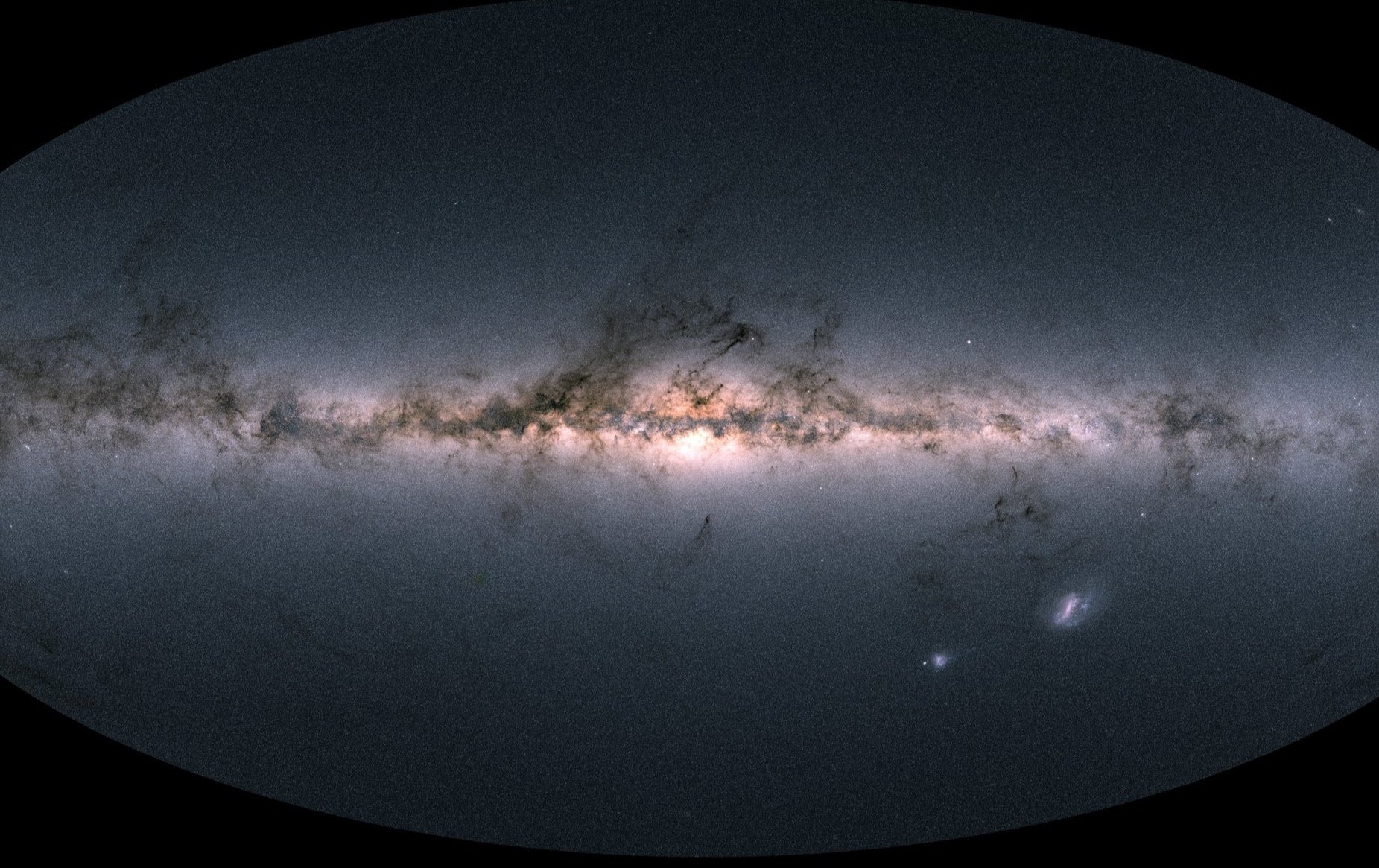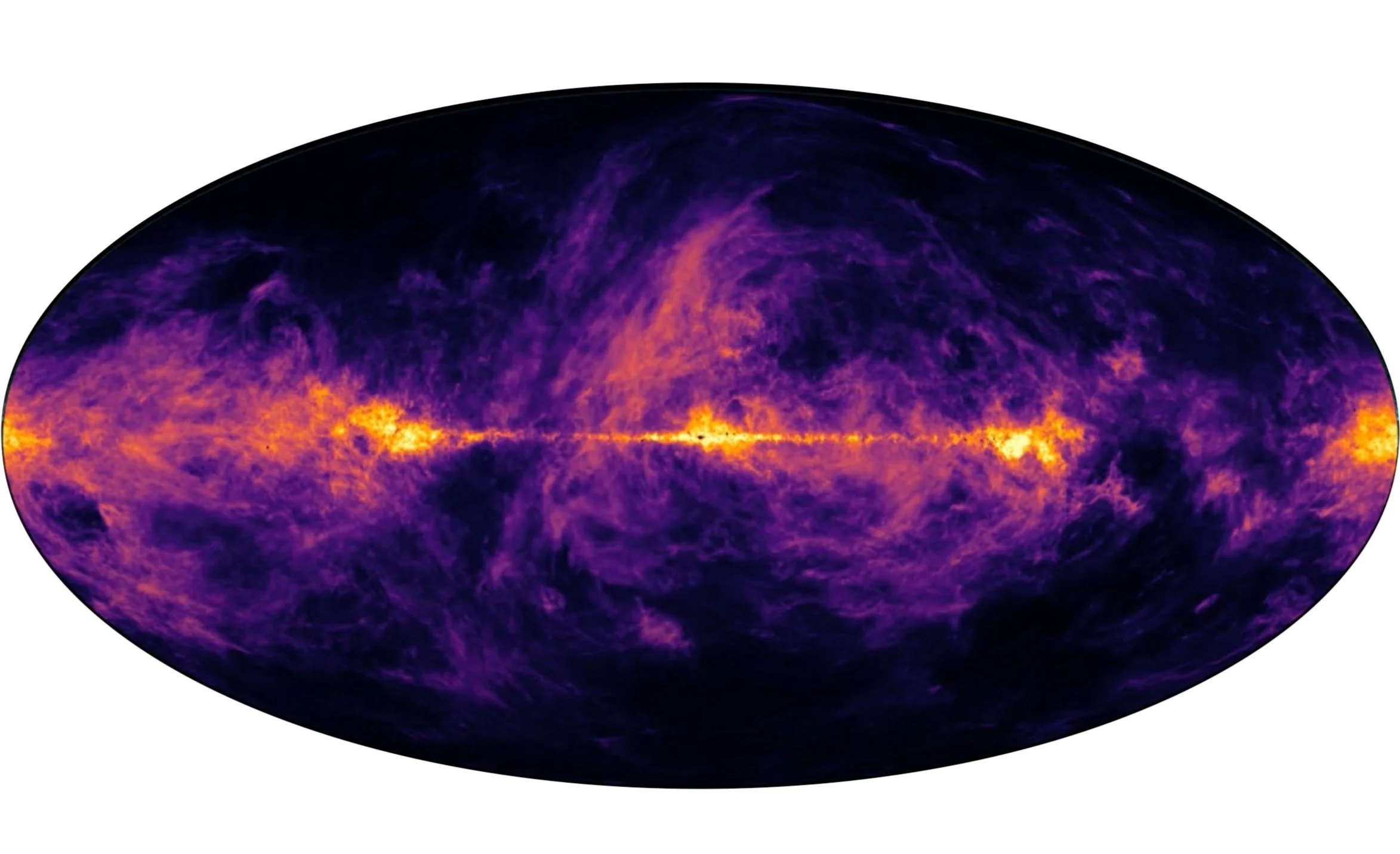
Our Milky Way
We need to observe many different wavelengths of light to get a complete picture of our Milky Way’s atmosphere
__________________________________
All-Sky Video — Panchromatic
Our Milky Way’s atmosphere emits light across all wavelengths of the electromagnetic spectrum. This video shows a sequence of images of the entire sky, sampling a wide range of wavelengths and revealing many different aspects of the Milky Way’s atmosphere. Each image is individually explained below.
-
All-Sky Image — Infrared Light

This oval image of the entire sky shows how the Milky Way appears from our viewpoint on Earth, as viewed in infrared light. Our edge-on view of the Milky Way’s disk spans the entire image from left to right. At its center is the Milky Way’s bulge.
An infrared picture provides a clearer view of the Milky Way’s stars than a visible-light picture because dust particles in the Milky Way’s atmosphere block much of our galaxy’s visible light. The only traces of that atmosphere in the image are the dark, reddish blotches along the disk.
The image is oval-shaped because it’s a map of the entire sky, analogous to a map of Earth’s entire surface. Its top shows what’s directly above the Milky Way. Its bottom shows what’s directly below the Milky Way. Both its left and right ends correspond to the direction opposite to the Milky Way’s center.
Source: 2MASS Survey
-
All-Sky Image — Visible Light

Cool clouds of dusty gas are more obvious in this visible-light image of the entire sky. Regions of the infrared image that are reddish in the infrared image look dark in the visible-light image, and dark clouds obscure our view in many more directions.
The two blobs of light toward the lower right are the Large and Small Magellanic Clouds, two smaller galaxies that neighbor our Milky Way galaxy.
Source: GAIA Mission
-
All-Sky Image — Microwaves

Observing microwaves coming from space reveals that the dust particles in the Milky Way’s atmosphere are glowing. If you compare this image with the visible-light image, you will see that many of the dark regions in that image are bright in this one.
Most of the glowing dust particles are in cold clouds concentrated within the Milky Way’s disk, but some of them belong to wispy clouds that extend above and below the disk.
Source: Planck Mission
-
All-Sky Image — Molecular Gas

Molecules in our galaxy’s atmosphere emit detectable radio waves. This image shows the radio waves from carbon monoxide, which is the best tracer of molecular gas because the signals from the far more abundant hydrogen molecules are much weaker.
The molecular gas clouds in our galaxy mostly reside in the disk and correspond to the darkest patches in the visible-light image. Star formation ends to happen within these clouds, because they are colder and denser than other forms of gas in the galaxy’s atmosphere, enabling gravitational compression to overcome pressure support.
Source: Planck Mission
-
All-Sky Image — Atomic Gas

Hydrogen atoms in our galaxy’s atmosphere also emit detectable radio waves. Comparing this radio-wave image of atomic hydrogen gas to the image of molecular gas shows that the atomic gas extends higher above the disk as well as farther below it, but is most abundant close to the central layer of the galaxy’s disk.
As the central layer of atomic hydrogen gas cools, it can form molecules that gravity pulls into denser clouds.
Source: HI4PI Survey
-
All-Sky Image — X-rays

Hot gas in our galaxy’s atmosphere can emit detectable X-rays if its temperature exceeds a million degrees. This image of X-ray emission across the entire sky shows that there is hot gas in nearly every direction around us.
Some of the disk’s gas clouds block the X-rays coming from farther away, producing dark regions in the disk corresponding to the dark regions in the visible-light image.
Source: eROSITA Survey
-
All-Sky Image — Gamma Rays

This all-sky image of gamma rays shows where high-energy cosmic rays in our galaxy are interacting with the particles in dense gas clouds. Its yellow and red regions indicating the most intense gamma-ray emission correspond closely to the blue regions in the molecular-gas image, which is where the galaxy’s densest gas clouds are.
Comparing the gamma-ray image with the X-ray image shows that the regions of greatest gamma-ray intensity correspond to the darkest regions of the X-ray image. The exceptions are the dots that are bright in both X-rays and gamma rays, which represent high energy photons coming from neutron stars in our galaxy.
Source: Fermi Mission
-
All-Sky Image — Magnetic Fields

Magnetic fields in our galaxy’s atmosphere cannot be seen directly with telescopes. However, dust grains in the atmosphere tend to align themselves with magnetic fields. The polarization of the infrared light and microwaves that those grains emit therefore tells us how the magnetic fields are aligned.
In this image of polarized microwave radiation from dust grains in our galaxy’s atmosphere, the lines that look like brush strokes indicate the directions of magnetic field alignment. Colors represent the intensity of the microwaves coming from the dust.
Source: Planck Mission
All-Sky Video — Rotation
Small wavelength shifts in the radio-wave emission from atomic hydrogen reveal how our galaxy’s atmosphere is rotating with respect to our viewpoint in the solar system. This video starts with gas that is moving most rapidly in our direction and ends with gas that is moving most rapidly away from us. As it progresses, you will see that gas on the left side is generally rotating toward us and gas on the right is rotating away.
Late in the video you will see the atmospheres of the Small and Large Magellanic Clouds appear toward the lower right.
Source: HI4PI Survey

